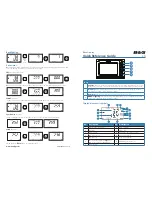
16. Click "OK" to close the Calibrate Sensor window, then
click anywhere in the Graph display to close the "Configure
sensors and measurements" menu.
About the Calibration
Calibration information is stored in the Wireless Drop Counter
and can be used by both PASCO Capstone and SPARKvue. The
information can be changed as needed. Note that if you use a
different liquid as the titrant, or if you change the drop rate or
drop size by adjusting the stopcock valves on the Drop
Dispenser, you will need to recalibrate.
Titration Setup
Figure 2. The titration setup, with the Wireless Drop Counter and syringe
holder mounted to a support rod.
Syringe with 50 mL of 0.1 M NaOH
Syringe Holder
Wireless pH Sensor
Stopcocks
Direct Connect pH Probe
Drop Tip
Wireless Drop Counter
150 mL Beaker with 100 mL of 0.005 M HCl
Micro Stir Bar
Magnetic Stirrer
Assemble the Titration Setup
1. Mount the Wireless Drop Counter on a support rod.
2. Attach a pH Probe to a Wireless pH Sensor (PS-3204).
Place the pH probe into the larger of the two sensor ports
on the Wireless Drop Counter.
3. Mount the Micro Stir Bar to the end of the pH Probe.
4. Arrange the magnetic stirrer and a 150 mL beaker with 100
mL of 0.005 M HCl, such that the end of the pH Probe and
the Micro Stir Bar are submerged in the liquid in the beaker.
5. Mount the Drop Dispenser above the Wireless Drop
Counter and position it so that the drop tip is placed over
the rectangular window of the Drop Counter. Fill the syringe
with 50 mL of 0.1 M NaOH.
Acid-Base Titration
1. Set up the equipment as shown in Figure 2, including
consumables.
2. Start PASCO Capstone or SPARKvue. Connect the
Wireless Drop Counter and a Wireless pH Sensor to the
software.
3. Use the software to create a graph display of pH (vertical
axis) vs. Fluid Volume (horizontal axis).
4. Start the magnetic stirrer. Check that the micro stir bar is
able to rotate.
5. In the software, click "Start" (SPARKvue) or "Record"
(Capstone) to begin recording data.
6. Adjust the stopcock valves on the Drop Dispenser so that
the titrant drops fall at about 1 drop per second.
7. Observe the data on the pH versus Fluid Volume graph.
After the equivalence point is reached, continue collecting
data until the pH curve flattens.
8. Close the stopcock valve and stop data recording.
Other Titrations
Titrations with different solutions can be performed using the
same equipment and procedure. Other probes, such as
conductivity or ORP, can be used in place of the pH probe.
Product Guide | 012-16026B
5

























